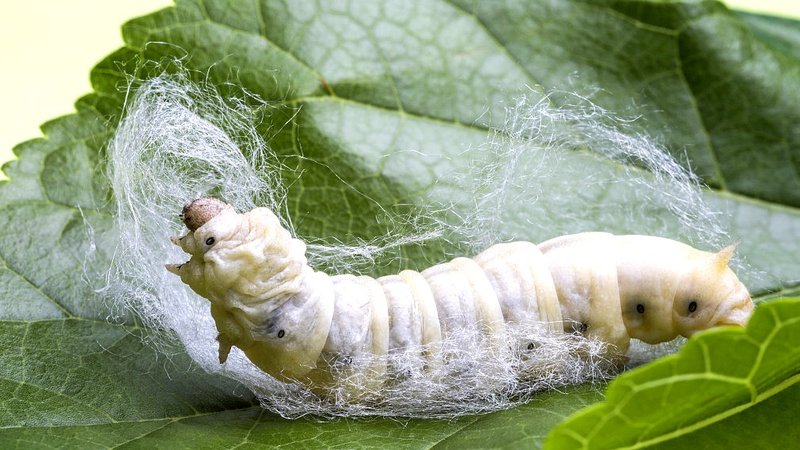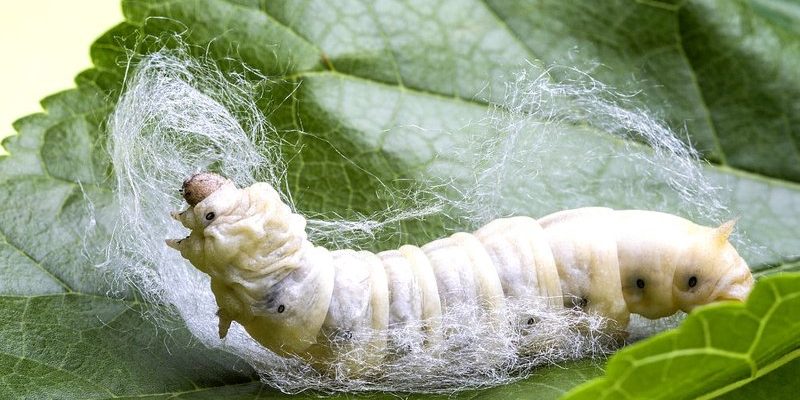
Domesticated silkworms, specifically *Bombyx mori*, have been bred for generations to produce silk efficiently and in large quantities. Wild silkworms, on the other hand, are a bit more elusive and often less familiar to the average person. They live in the wild and have adapted to their surroundings in ways that make them quite different from their domesticated counterparts. Let’s dig deeper into the intriguing world of these two kinds of silkworms and explore the key differences between them.
What Are Wild Silkworms?
Wild silkworms can be found in various environments around the world. Unlike their domesticated relatives, these silkworms do not rely on humans for their survival. Most wild silkworms belong to the *Bombyx* genus but have adapted to live in natural habitats, eating a variety of leaves from different trees. This diversity in diet helps them survive in the wild, making them more resilient to environmental changes.
The life cycle of wild silkworms is also fascinating. They undergo the same metamorphosis stages as domesticated silkworms: egg, larva, pupa, and adult moth. However, wild silkworms often take longer to grow, as they face challenges in finding food and evading predators. This tough upbringing means they tend to develop different survival skills compared to their domesticated cousins.
One interesting fact about wild silkworms is that they often produce silk that is less uniform than that of domesticated silkworms. This silk can be thicker and coarser, resulting in a different texture than the silky smooth fabric most people are familiar with. Isn’t it wild to think that the environment plays such a big role in how these creatures create their silk?
What Are Domesticated Silkworms?
Domesticated silkworms are like the superstars of the silk world. Bred by humans over thousands of years, they have been fine-tuned for one main purpose: producing silk. Typically, you’ll find them in controlled environments, where farmers can carefully manage their diet and living conditions. They primarily feed on mulberry leaves, which not only helps them grow faster but also ensures that the silk they produce is of high quality.
These little silk machines have a much shorter life cycle compared to wild silkworms. Where wild silkworms might take several months to mature, domesticated ones can go from egg to cocoon in just a few weeks. This rapid turnover is one reason why silk production can be such a lucrative business. Imagine having a plant that grows fruits or vegetables super fast; that’s pretty much how domesticated silkworms work for silk farmers.
Domesticated silkworms also produce uniform silk strands, which makes it easier for manufacturers to weave beautiful fabrics. Their cocoons are often harvested before they hatch into moths, ensuring that the silk remains unbroken. This process highlights just how intertwined these silkworms are with human needs and industry.
Physical Differences
If you’ve ever seen a wild silkworm, you might notice that it looks a bit different from a domesticated one. Wild silkworms often have a more varied appearance due to their diverse diet. Their bodies might have different colors or patterns, helping them blend into their natural surroundings and avoid predators. This camouflage is a fascinating example of nature’s creativity.
On the flip side, domesticated silkworms usually have a specific appearance: a plump and pale body, often with a more uniform shape. This is a direct result of selective breeding. Farmers have chosen silkworms that produce the best and most consistent silk, leading to the look we commonly associate with these creatures today.
Another key difference is their size. Generally, domesticated silkworms grow larger than wild ones. This size difference can be attributed to the controlled environment and consistent feeding they receive. Imagine how both kinds of silkworm are essentially shaped by their surroundings and lifestyle.
Silk Production and Quality
When it comes to silk production, there’s a world of difference between wild and domesticated silkworms. Domesticated silkworms are known for their ability to produce long, continuous silk threads. This is what makes them so valuable in the textile industry. The silk is highly sought after for its smoothness and durability, translated into beautifully made garments and accessories.
Wild silkworms, while still capable of producing silk, tend to create shorter and thicker threads. The silk they produce can vary greatly in texture. This might sound undesirable, but it actually results in unique, earthy fabrics that some artisans love to use. Think of it like the difference between a standard, mass-produced t-shirt and a handmade artisan piece; both have their charm but cater to different tastes.
The process of harvesting silk also differs. For domesticated silkworms, farmers take great care to collect cocoons before the moths emerge, as this prevents the threads from breaking. In contrast, with wild silkworms, collecting silk can be more challenging, often requiring foraging in their natural habitats. It’s a bit like gathering wildflowers versus picking blooms from your garden.
Behavior and Lifecycle
Let’s take a moment to chat about behavior. Wild silkworms have developed naturally, so they have instincts that help them navigate their environment. They are more cautious and tend to hide from potential threats. Since they live in the wild, these behaviors are essential for their survival. You might even say they have a bit more street smarts!
In contrast, domesticated silkworms have become accustomed to human care. They are less skittish and more reliant on farmers for their food and safety. This difference creates a rather tame lifestyle for them. You can imagine how a pet cat behaves differently than a cat you’d find roaming outside; that’s the same sort of shift we see here.
As for their lifecycle, both types of silkworms go through the same four stages: egg, larva, pupa, and adult moth. However, domesticated silkworms have a much simpler and quicker lifecycle due to their controlled environments. Wild silkworms face challenges that can extend their growth and development, creating a more complex life cycle.
Environmental Impact and Sustainability
You might be wondering how wild and domesticated silkworms impact the environment. Let’s break it down. Wild silkworms play a role in their ecosystems, helping to maintain balance by feeding on plants and supporting the food chain. Their natural existence contributes to biodiversity, which is super important for a healthy planet.
On the other hand, the process of raising domesticated silkworms can have a more significant impact on specific environments. Large-scale silk production often involves monocultures, where one type of plant is grown in a large area. This can reduce biodiversity and impact the surrounding ecosystem. However, many farmers are now looking into more sustainable practices to lessen this impact.
Sustainability is a big topic of discussion these days, and it’s important for consumers to consider where their silk comes from. When you choose silk products, knowing whether they come from wild or domesticated silkworms can help you make more informed decisions. It’s a bit like knowing the backstory of your food—where it comes from matters!
So, what’s the takeaway when we compare wild and domesticated silkworms? Both types of silkworms are unique and essential in their own rights. Wild silkworms thrive in their natural habitat, showcasing the beauty and diversity of nature, while domesticated silkworms have been perfectly crafted by humans to meet our needs for silk production.
Understanding these differences not only gives us a greater appreciation for silk but also reflects on how humans interact with nature. Whether you’re drawn to the wild, untamed beauty of wild silkworms or the productivity of their domesticated cousins, both play a role in the intricate tapestry of life. Next time you see a silky fabric, think about all the hard work, history, and differences behind those tiny worms that make it all possible!

